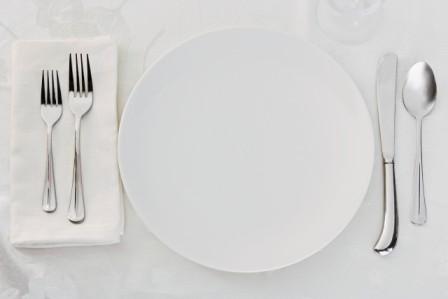|
Portion Control Tips And The Twenty Minute Rule
Take a look in your cupboard. How big are your dinner plates? Are they the usual 12” plates or are you using something smaller? More importantly, are you filling the plate and stuffing your body or are you leaving some breathing room? Think about that for a moment and answer yourself honestly. Do you employ portion control? Consider the size of your stomach – not the size of your abdomen. Your stomach is normally the size of your fist and it stretches to accommodate the amount of food you consume. Make a fist. Look at it. Now make two fists and put them on your dinner plate. How much empty space can you see on the plate? Even if you add an imaginary third fist, there is still breathing room on your plate. When you eat dinner, be conscious of the breathing room on your plate (in other words, make sure you have some empty space).
Vegetables are special. I recommend getting as many different colours of vegetables as you can handle with each meal. The nutrients found in vegetables are easily recognized and absorbed by your body and due to their low calorie/high fibre content you can eat more than one fist size and not feel like you just blew your healthy eating plan. So try replacing your fist of starches/staples with an extra fist of vegetables for every second meal.
Have you heard of the twenty minute rule? It’s the time it takes for your brain to get the message that your stomach is full. How fast do you eat? Do you use large utensils and shovel your food in while watching television or busily typing on your computer? This is a recipe for disaster. When you eat while distracted you tend to eat faster, put larger portions in your mouth at one time, and not chew your food sufficiently. Chewing your food sufficiently is important for several reasons. Chewing breaks down the food into smaller pieces, creating more surface area for your saliva to get at. Your saliva contains enzymes that help break down your food. If your food is not chewed sufficiently the larger pieces may not be digested completely in your gut and may become a meal for opportunistic bacteria in your colon, leading to indigestion, an abundance of flatulence, and bacterial overgrowth. Eating faster allows you to put more food into your stomach during the twenty minute window. If you want to break this cycle try shutting off the television and the computer and sitting down at the dinner table with your plate, small utensils, and a napkin. Play some relaxing music in the background to help slow your brain waves and relax your body. This will facilitate chewing your food sufficiently before swallowing. Before you know it, you’ll have been at the table for twenty minutes and your brain will have received the signal that your stomach is full – and you won’t feel “stuffed”. One last tip: A vision without a plan is a hallucination and will not lead to a realization. Plan to succeed with proper portion control.
|


